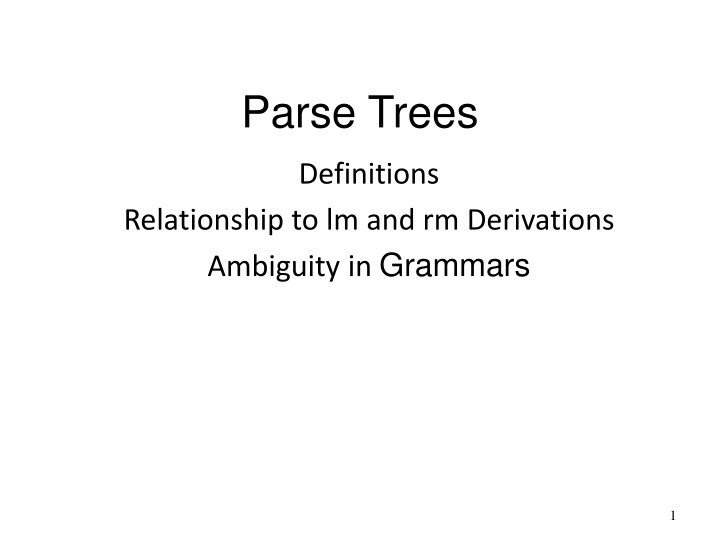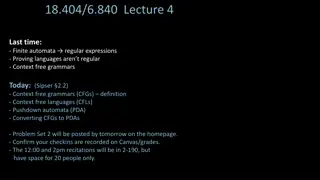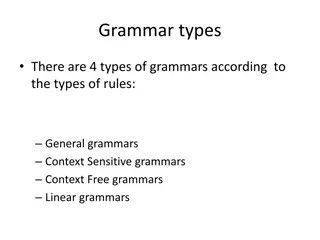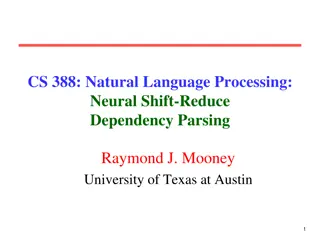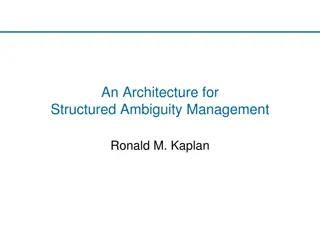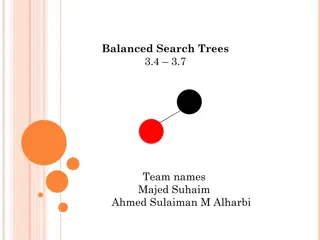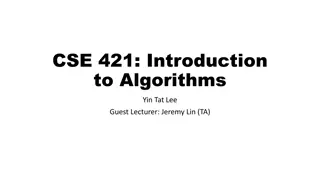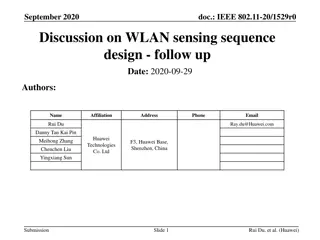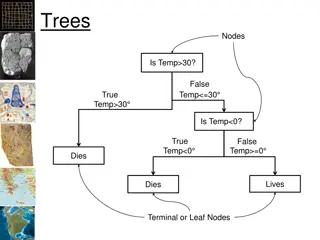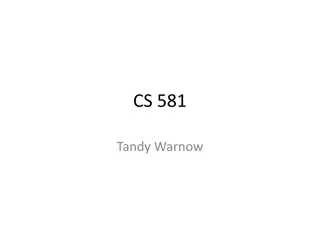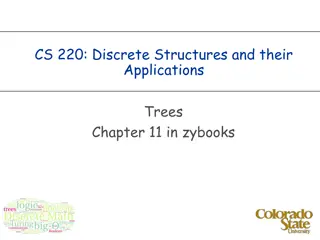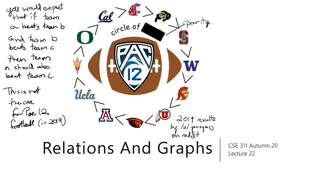Parse Trees and Ambiguity in Grammars
Graphical representations of derivations through parse trees in context-free grammars (CFG). Understand the relationship between left-most (lm) and right-most (rm) derivations, showcasing ambiguity in CFGs with examples. Dive into the identical parse trees of lm and rm derivations, dissecting strings and configurations. Learn about ambiguous CFGs and their properties, including dual derivations and distinct parse trees. Uncover proofs of ambiguity and delve into ambiguous CFGs through intricate examples.
Download Presentation

Please find below an Image/Link to download the presentation.
The content on the website is provided AS IS for your information and personal use only. It may not be sold, licensed, or shared on other websites without obtaining consent from the author.If you encounter any issues during the download, it is possible that the publisher has removed the file from their server.
You are allowed to download the files provided on this website for personal or commercial use, subject to the condition that they are used lawfully. All files are the property of their respective owners.
The content on the website is provided AS IS for your information and personal use only. It may not be sold, licensed, or shared on other websites without obtaining consent from the author.
E N D
Presentation Transcript
Parse Trees Definitions Relationship to lm and rm Derivations Ambiguity in Grammars 1
Parse Trees: graphical representations of derivations Parse trees have nodes labeled by symbols of a CFG. Leaves: labeled by a terminal or . Interior nodes: labeled by variables. Children are labeled by the right side of a production for the parent. Root: labeled by the start symbol. Yield: string produced by concatenation of leaves left-to-right 2
Example: Parse Tree for Derivation of (())() in S -> SS | (S) | () S =>lm SS =>lm (S)S =>lm (())S =>lm (())() S =>rm SS =>rm S() =>rm (S)() =>rm (())() S S S ( S ) ( ) Yield: (())() ( ) 3
Parse trees of lm and rm derivations are the same. Only affects which branch you assemble first. S =>lm SS =>lm (S)S =>lm (())S =>lm (())() S =>rm SS =>rm S() =>rm (S)() =>rm (())() S S S ( S ) ( ) Yield: (())() ( ) 4
For CFG with start symbol S and productions S->A1B A->0A|e B->0B|1B|e Show that the parse trees of lm and rm derivations of string 00101 are identical 5
S->A1B A->0A|e B->0B|1B|e Show that the parse trees of lm and rm derivations of string 00101 are identical The sequence of the derivation is root to leaves. Yield by read left to right determines configuration of branches. Hence, parse trees have no leftmost or rightmost distinction. 6
Ambiguous CFGs 3 equivalent properties of ambiguous CFGs 1. There is a string in the L(CFG) that has two different leftmost derivations. 2. There is a string in the L(CFG) that has two different rightmost derivations. 3. There is a string in the L(CFG) that is the yield of 2 distinct parse trees Proof of any one of these shows that CFG is ambiguous 7
Prove S -> SS | (S) | () is ambiguous by 2 left-most derivations of ()()() and by 2 parse trees. Work on board 8
S -> SS | (S) | () is ambiguous Prove by 2 lm derivations of ()()() S=>SS=>SSS=>()SS=>()()S=>()()() S=>SS=>()S=>()SS=>()()S=>()()() Branches of parse tree can be exchanged because yield is the same read L->R and R->L 9
CptS 317 Fall 2023 Assignment 12, Exercises 5.4.1 text p 215 Use string aab to show that S->aS|aSbS| is ambiguous by all 3 methods: 2 left-most, 2 right-most, and 2 parse trees. 10
Exercise 5.4.3 p216 Remove the ambiguity in S->aS|aSbS| As you will demonstrate in HW12, derivations of aab can start with either S=>aS or S=>aSbS. To remove ambiguity in derivation of aab we change the production S=>aSbS to one that forces only one way to start. Example: add variable T with productions such that starting with S=>aTbS cannot produce aab by lm steps. 11
Show on board that in CFG S->aS S->aTbS S->e T->aTbT T->e the left-most derivation of aab is unique Do on board 12
Easy to prove ambiguous. Only requires one string Hard to prove unambiguous Removing ambiguity in derivation of aab does not prove that S=>aS|aTbS|e with T=>aTbT|e is unambiguous. Difficult to know if changes designed to avoid ambiguity in derivation of aab apply to all strings in L(CFG) Change to CFG must preserve the content of L(CFG) 14
Ambiguity is a Property of Grammars, not Languages Same CFL may have ambiguous and unambiguous CFGs Example: balanced-parentheses CFL Recall, S -> SS | (S) | () shown to be ambiguous by 2 lm derivations of ()()() Balanced-parentheses CFL also has an unambiguous CFG 15
Unambiguous balanced-parenthesis CFG B -> (RB | R -> ) | (RR B is the start symbol Derivations must start with B ->(RB To expand with ( , use R->(RR To expand with ) , use R ->) End with B-> Example of LL(1) CFG: Leftmost derivation, left-to-right scan, one symbol of look-a-head. 16
Unambiguous balanced-parenthesis CFG B -> (RB | R -> ) | (RR Example derivation of (())() by LL(1) Work on board 17
Unambiguous balanced-parenthesis CFG B -> (RB | R -> ) | (RR Example derivation of (())() B =>lm (RB =>lm ((RRB =>lm (()RB =>lm (())B (())B =>lm (())(RB =>lm (())()B =>lm (())() At each lm step, the production needed is uniquely defined. 18
LL(1) Grammars By construction obviously unambiguous You can always figure out the production to use in a leftmost derivation by scanning the given string left-to-right and looking at the next symbol only Most programming languages have LL(1) grammars. 19
Inherent Ambiguity Not every ambiguous grammar can be fixed as was the case with the balanced- parentheses grammar. Some CFL s are inherently ambiguous; every grammar for the language is ambiguous. 20
Example: Inherent Ambiguity The language {0i1j2k | i = j or j = k} is inherently ambiguous. At least some of the strings of the form 0n1n2n can be generated by two left-most derivations depending on which you check first: equal number of 0 s and 1 s or equal number of 1 s and 2 s. 21
Example of ambiguous grammar for {0i1j2k | i = j or j = k} S -> AB | CD A -> 0A1 | 01 B -> 2B | 2 C -> 0C | 0 D -> 1D2 | 12 There are two leftmost derivations of every string with equal numbers of 0 s, 1 s, and 2 s. Show true for n=2, w=001122, with 2 lm derivations Show on board A generates equal 0 s and 1 s B generates any number of 2 s C generates any number of 0 s D generates equal 1 s and 2 s 22
Example of ambiguous grammar for {0i1j2k | i = j or j = k} S -> AB | CD A -> 0A1 | 01 B -> 2B | 2 C -> 0C | 0 D -> 1D2 | 12 A generates equal 0 s and 1 s B generates any number of 2 s C generates any number of 0 s D generates equal 1 s and 2 s lm: S => AB => 0A1B =>0011B => 0112B => 001122 lm: S => CD => 0CD=>00D => 001D2 => 001122 23
